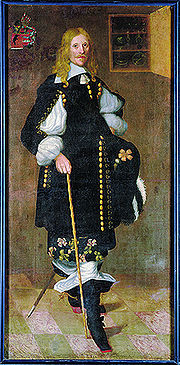
Lauritz Galtung
Encyclopedia

Norway
Norway , officially the Kingdom of Norway, is a Nordic unitary constitutional monarchy whose territory comprises the western portion of the Scandinavian Peninsula, Jan Mayen, and the Arctic archipelago of Svalbard and Bouvet Island. Norway has a total area of and a population of about 4.9 million...
nobleman of the Galtung
Galtung
Galtung was a Norwegian noble family dating from the ennoblement of Lauritz Galtung in 1648. However, when he was ennobled, it was expressed that there existed an older noblement...
-family who was educated in the military, and became Admiral
Admiral
Admiral is the rank, or part of the name of the ranks, of the highest naval officers. It is usually considered a full admiral and above vice admiral and below admiral of the fleet . It is usually abbreviated to "Adm" or "ADM"...
of the Dano-Norwegian joint fleet. He was employed Seignory
Seignory
In English law, Seignory or seigniory , the lordship remaining to a grantor after the grant of an estate in fee simple....
over Lister len
Vest-Agder
In the 16th century, Dutch merchant vessels began to visit ports in southern Norway to purchase salmon and other goods. Soon thereafter the export of timber began, as oak from southern Norway was exceptionally well suited for shipbuilding...
in 1658.
Biography
Lauritz Galtung was born at the family farm of Torsnes in HardangerHardanger
Hardanger is a traditional district in the western part of Norway, dominated by the Hardangerfjord. It consists of the municipalities of Odda, Ullensvang, Eidfjord, Ulvik, Granvin, Kvam and Jondal, and is located inside the county of Hordaland....
. He is the first in the family to have been called the younger Galtung-family, as he used Galtung rather than the earlier Galte. His father, Lauritz Johannessen Galte, was one of the biggest landowners in Hardanger. The tax-census of 1647 shows that he owned 32 farms or farmparts in Hardanger, 13 in Sunnhordaland, and 6 in Voss
Voss
is a municipality in Hordaland county, Norway. It is part of the traditional district of Voss. The administrative center of the municipality is the village of Vossevangen....
.
Family
He was first married to Danish noblewoman Clara Gere of Bjørnstrup; however she died in 1647, only a few months after the marriage. In 1650 he got married again, to another Danish noblewoman, Barbara Grabow. Barbara and Lauritz eventually got six children, the first four born in Bjørnstrup, ScaniaScania
Scania is the southernmost of the 25 traditional non-administrative provinces of Sweden, constituting a peninsula on the southern tip of the Scandinavian peninsula, and some adjacent islands. The modern administrative subdivision Skåne County is almost, but not totally, congruent with the...
, and the last two born at Huseby, Farsund after moving to Norway
Norway
Norway , officially the Kingdom of Norway, is a Nordic unitary constitutional monarchy whose territory comprises the western portion of the Scandinavian Peninsula, Jan Mayen, and the Arctic archipelago of Svalbard and Bouvet Island. Norway has a total area of and a population of about 4.9 million...
in 1658 (as a result of the Danish loss of Scania by the terms of the Treaty of Roskilde
Treaty of Roskilde
The Treaty of Roskilde was concluded on 26 February or 8 March 1658 during the Second Northern War between Frederick III of Denmark–Norway and Charles X Gustav of Sweden in the Danish city of Roskilde...
).
Literature
- H. D. Lind. Kong Frederik den Tredjes Sømagt. Det dansk–norske Søværns Historie 1648–1670. I Den Milo’ske Boghandel, Odense, 1896.
- Johan Ellertsen Galtung. Galtungslekten i fortid og nutid. Eget forlag, Oslo, 1974.
- Elin Galtung Lihaug. «Grabow, Galtung — og Pusjkin; Søkelys på en europeisk slektssammenheng». Norsk Slektshistorisk Tidsskrift, 39, 93–133, 2003.
- Elin Galtung Lihaug. «Aus Brandenburg nach Skandinavien, dem Baltikum und Rußland. Eine Abstammungslinie von Claus von Grabow bis Alexander Sergejewitsch Puschkin 1581–1837». Archiv für Familiengeschichtsforschung, 11, 32–46, 2007.

